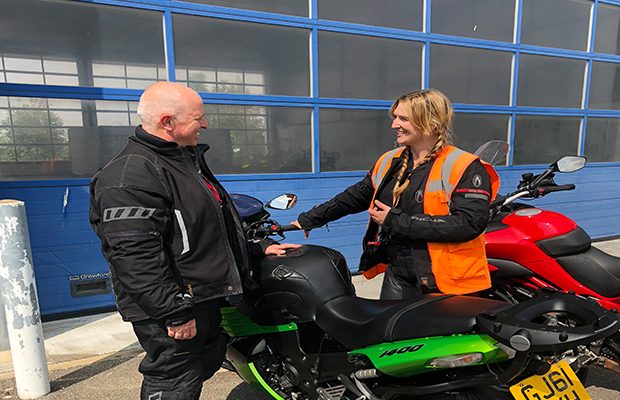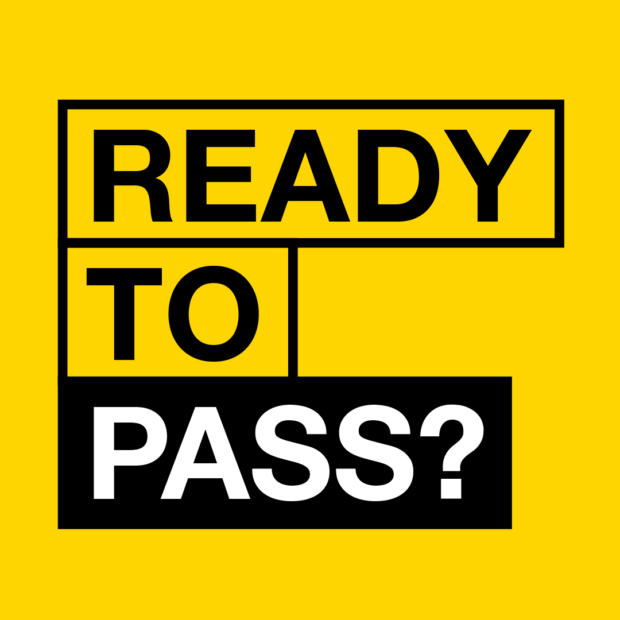
Have you recently passed your motorcycle test? Have you thought about any further training? Perhaps you’ve been riding for many years without any formal training? Well, the enhanced rider scheme (ERS) might be for you!
ERS offers both experienced and new riders the opportunity to enhance their skills under the tuition of professionally qualified motorcycle instructors.
DVSA relaunched the scheme in June of this year and since then 254 trainees have successfully completed the course. We also now have 208 ERS trainers on the register, and Laura Smith from Midland based RMT Motorcycle Training is one of them.
Laura is also a qualified compulsory basic training (CBT) and direct access scheme (DAS) trainer, and in this blog post she answers some of our questions about ERS.
Laura, how does the new scheme work?
Your instructor will ask you about your riding history and experience before offering an assessment ride. This gives them the opportunity to look at every aspect of your riding, from cornering, to slow control, overtaking along with your planning and awareness.
When they’ve seen how you ride, the instructor will then be able to focus on what areas need improvement.
How it can benefit my riding?
For many of my students, cornering, bend assessment and overtaking are the areas they struggle with the most.
What a difference it would make to know the severity of the bend before you’re in it. How nice would it feel to be able to overtake with a plan, knowing exactly where you’ll execute the overtake and when to get back into position?
These are skills ERS trainers can work on, making sure that the training day works for you and your needs.
So, whilst it may be that your current riding skills mean that you only need one day to gain your ERS qualification, it may take some riders up to 3 days. But in my opinion, you can never learn enough. Quite often a “top up” of skills is always useful, especially after a break from riding.
What kind of experience will I have during the training?
I’d say you’ll find the training enjoyable and fun!
Training after a break can seem daunting and the thought of another person having an opinion on your riding off-putting, but the beauty of ERS is that it’s delivered by fully qualified advanced instructors. They’re trained to deliver advanced riding skills in a professional environment.
While other training days might offer a cheaper way of learning, they can sometimes be a lengthier way of gaining the right skills, as the training is more generic. The ERS is also the only DVSA-approved training course!
Another great thing about ERS training is that we work on the same skills that all advanced riders use to improve their riding, but there’s no formal test. We know riding under test conditions can be uncomfortable and sometimes can even affect your riding.
Instead, ERS means you can enjoy learning new skills, and understand and use advanced riding techniques while gaining a qualification at the same time. What’s not to love?
Students are often surprised about the amount they can learn in a day - usually so much that they need time to absorb and practise before they come back in for their next session. This reflection and practise time allows students to build up their skills progressively.
What happens after I’ve completed the scheme?
Once you’ve completed your ERS qualification, you’ll be in a position to move to an advanced test.
Both the Institute of Advanced Motorists (IAM) and the Royal Society for the Prevention of Accidents (RoSPA) organise ride outs and assessment rides with a view to putting you forward for a test.
By completing ERS you’ll be in a far better position to put in for your advanced test because of the skills you’ve learnt from your fully qualified professional instructor. This should save you the time and money of taking more lessons.
ERS offers core modules, which you can see in the ERS syllabus, as well as extra modules that can be a further addition to your qualifications.
Some of these include riding abroad (which could include a continental tour), group riding, blood bikes and riding off-road. I’d recommend checking out the extra modules your trainer can offer and how this might benefit your riding.
Find a DVSA ERS trainer
If you’re interested in doing the DVSA enhanced rider scheme, you can find a qualified ERS instructor near you on GOV.UK.

9 comments
Comment by Bob Craven posted on
Looks like a pre Advance riders training and as such it does say that they will be looking at cornering, bends overtakes etc everything that an Advanced rider does over several weeks.
Its interesting to note that it says that those dangers mentioned above are the areas that motorcyclists struggle with and yet the vast majority of Advanced training concentrates on just those areas. That said , after many decades of Advanced Training that still some 60% of collisions and incidents, resulting in death or serious injury, occur on our country roads and on bends, cornering and overtakes
Seems to me that there is something fundamentally wrong with our training if after the last 50 years or so of Advanced training they are still happening. Could it just be that with training we are encouraging more overtakes or just more speed than should be entered into or that we are approaching bends all wrong and again at too great a speed and forgetting the first golden rule rule that we should "never sacrifice safety for the sake of any other consideration or expedience" and the second most important rule that "we should always be in a position to stop in the distance that we can see to be clear in the road ahead and on our side of the road" That means whilst approaching any bend and in particular any blind left hand bends, which are the most dangerous of bends and taking them too fast and without the necessary caution or considerations mentioned above we are encouraging accidents to happen.
Finally many riders who undertake the CBT do not want to particularly go on and ride on country road but just want to commute and use main roads and routes or ride around towns and other urban areas as couriers or food delivery persons and as such this form of training which again primarily is aimed at out of town riding will not suite or appeal in any way to them. So we have already lost about 70% of our demographic.
Comment by Gavin Caldicott posted on
Do not discount 'human nature' my friend. With/definitely WITHOUT training, humans THINK they are 'better/higher skilled' than they invariably are!
Add this to SPEED, FREEDOM, ADRENALIN, you have the recipe for 'a problem', even if you dial-in a 'sensible head'!!!
NO TRAINING: idiot!
TRAINING: of course!!
FURTHER TRAINING:??!!!
DON'T ENGAGE YR HEAD, at least 100%, EVERY RIDE:
Potential death!!!!
SHARING THE ROAD WITH OTHER ROAD USERS: with training, advanced training, head engaged 100%, CAPTAIN SENSIBLE!!!:
potential death!!!!!!
Moral of the story: enjoy riding, PLEASE be careful, ALWAYS!!!!!!!
We are all only a 'breath away' from 'The End'.
'A Biker'❤️❤️❤️?
Comment by Derek Dew posted on
The scheme itself is a great scheme but unfortunately whereas the old scheme gave a "paper trail" from student to instructor to DVSA and ultimately to any insurance company, I feel that this trail now does not include the instructor (name and RPMT number). This lends itself to misuse i.e. who conducted this course? is he or she qualified? how many courses does this instructor get involved with etc..
Comment by Les harvey posted on
Is it true there are more fatal accidents now.than when you could ride a 250cc on l plates
........
Comment by Bob Southgate posted on
The problem with advanced training is the very small number of motorcyclists that actually take it. I think that only abut 5% of motorcyclists go on to take it, so the problem areas are still going to present problems for the vast majority. There is nothing wrong with advanced training, apart from not enough people are taking it.
Comment by Mike Abbott posted on
Great blog by Laura.
Regarding Bob Craven's interesting comments, the problem is that so few riders complete any form of post-test, advanced, off- road or track training - we're all only just scratching the surface.
Comment by Kenneth Huntley 800058 posted on
I have spoken with the DVSA about the ERS. You state 'Once you’ve completed your ERS qualification, you’ll be in a position to move to an advanced test' this does nothing to improve the perception that the ERS is a second rate program in the eyes of Blood Bikes. Blood Bikes require an advanced qualification delivered correctly is this not an advanced qualification delivered by qualified instructors. Interested to know if you will be making changes to the paperwork as discussed on the phone.
Comment by Stephen Tait posted on
Hi Bob
I have no figures to back this up but have you considered that the riders who are crashing on country roads are the ones who have not had any advanced instruction?
Having being a DVSA instructor CBT & DAS, and IAM Car and Motorcycle qualified for 25 years, I have no doubt further training does improve rider skills.
Comment by Mike Abbott posted on
Interesting well written and informative article.
However, advanced training is based on Police Roadcraft, which is a different standard, where riders are also encouraged to do things that the Highway Code says you 'should not'. I think maintaining the difference in standards is important.
ERS is primarily about safety, Advanced is more about making 'good progress' and bending the rules.
But the main issue is the lack of marketing and interest in both. Only a very small and I suspect a reducing percentage of riders do either, so we're only scratching the surface, so the accident rate and fatalities continue unabated.
The likely advantages of extra training and rider development need to be promoted, which also means being open and honest about the risks of riding a motorcycle - 57 times higher than driving a car.